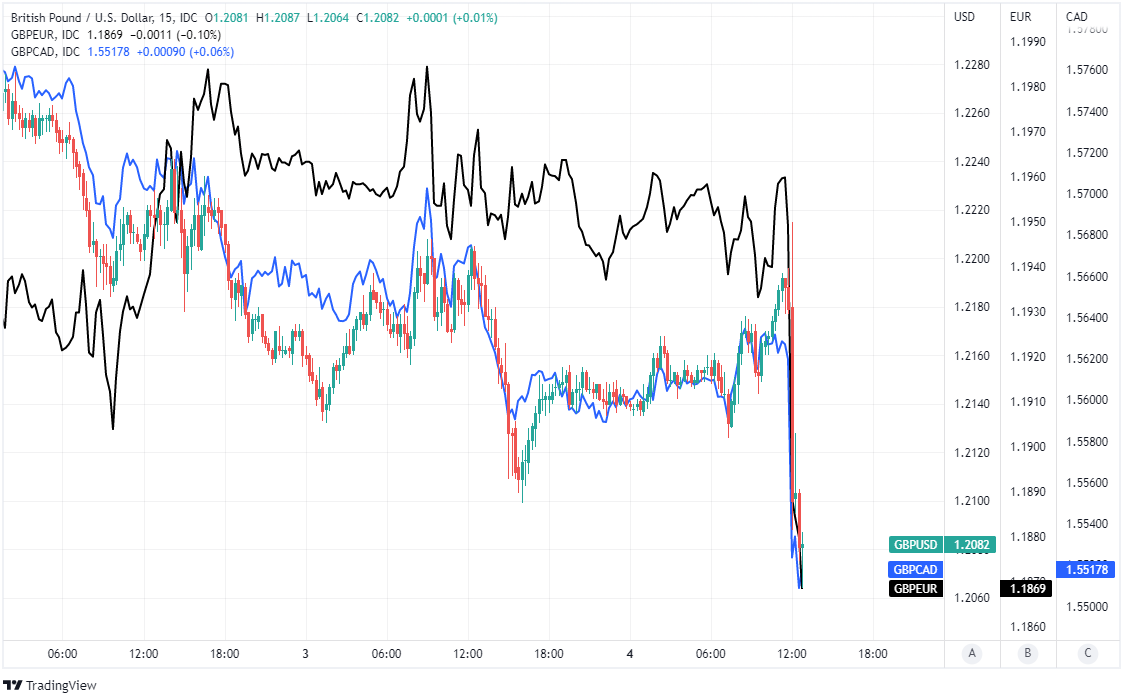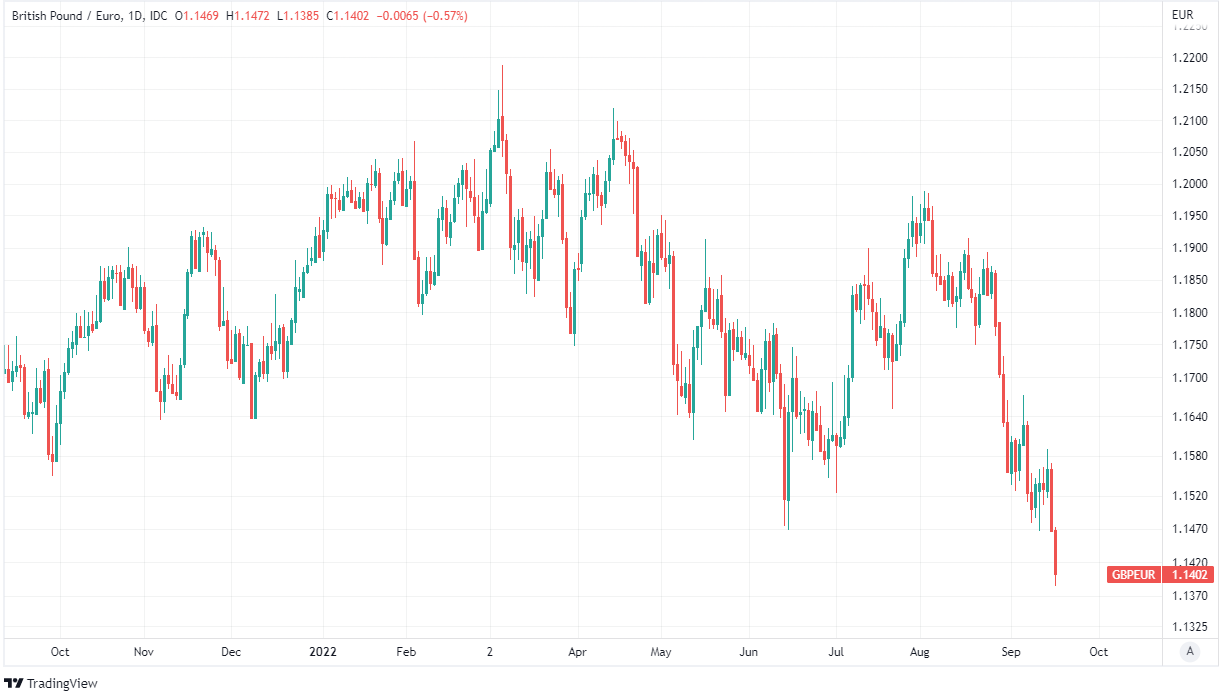GBP/EUR Week Ahead Forecast: Risk of Historic Lows and 'Black Thursday'
- Written by: James Skinner
- GBP/EUR may fall to 1.0108 with overshoot or test of parity possible
- BoE could hit Bank Rate ball out of park but GBP still risks a drubbing
- Negative real yields & UK’s budget deficit considerations key drivers
- Depreciation a possibly necessary adjustment; no cause for concern
- GBP/EUR also not a way street as midweek short-squeeze possible
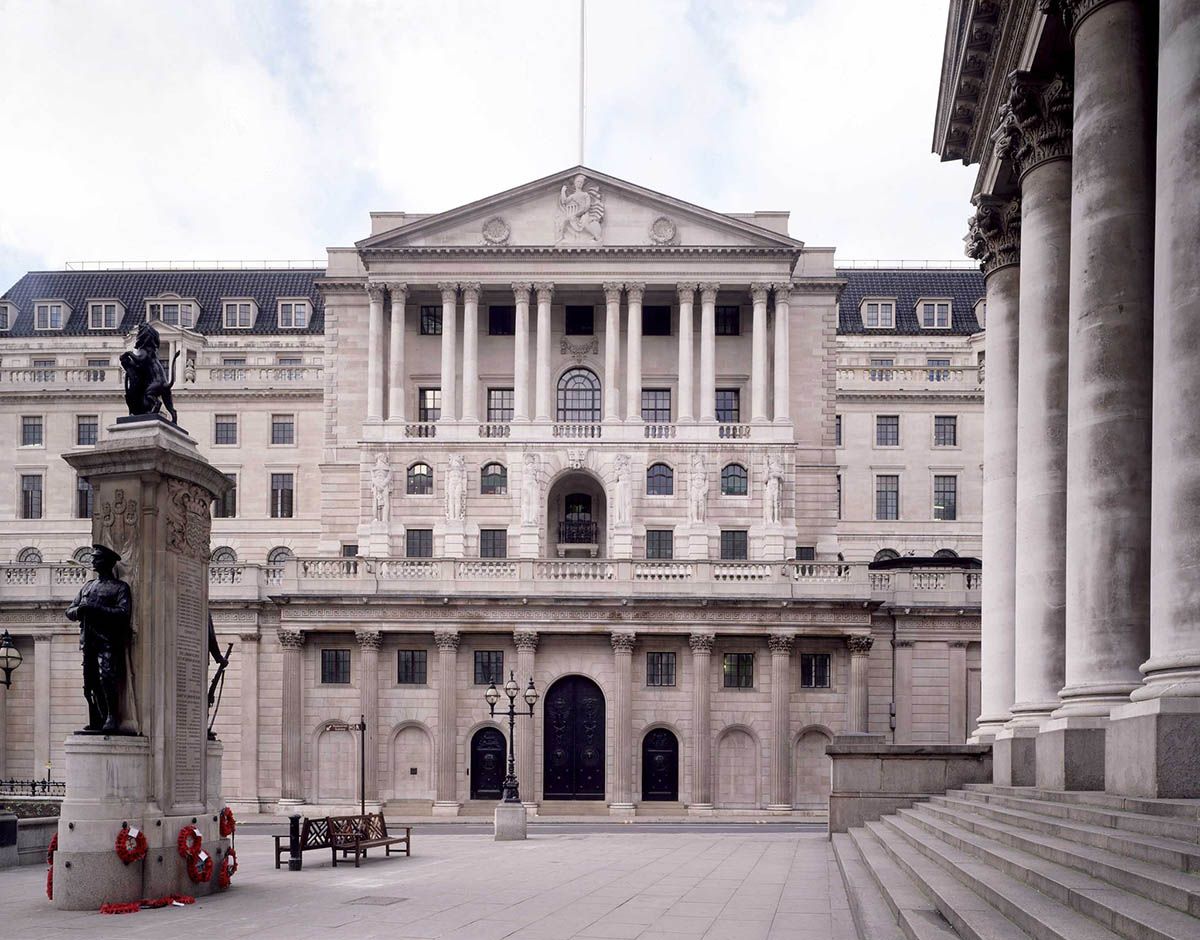
© Bank of England
The Pound to Euro exchange rate has notched up a seven week run of losses but could fall much further this week and potentially to all-time lows if the market takes fright at a possible Thursday monetary policy decision by the Bank of England (BoE) to lift Bank Rate significantly.
Sterling entered a holiday-shortened week near its lowest against the Euro since February 2021 and in the midst of its longest stretch of losses for three years.
However, it may also be on the cusp of exceptional volatility that could include a 'Black Thursday' kind of slide as far as all-time lows near to parity.
Key to whether with this happen is the size of the latest increase in Bank Rate on Thursday and any clues or guidance about the outlook for the benchmark, although the risk is of the BoE feeling compelled to hit the ball out of a metaphorical park this week.
“It’s hard to see any Sterling supportive outcomes from next week’s BoE meeting. An aggressive hike is likely to be judged as Sterling negative through dampening growth expectations further and raising the bar for supportive capital flows,” says Paul Robson, Natwest Markets’ Europe head of G10 FX strategy.
“A dovish outcome risks the currency being penalised by a lack of carry,” Robson and colleagues wrote in a Friday research briefing.
Above: Sterling exchange rate reaction to August monetary policy decision. Click image for closer inspection. To stay on top of the market set your own free FX rate alert, here.
Thursday's decision will follow Office for National Statistics data revealing last week that core inflation rose again in August and an Inflation Attitudes survey from the BoE suggesting households' expectations of medium-term inflation remained at possibly-concerning levels last month.
"Market pricing is torn between the MPC doing a 50bps or a 75bps hike. Economists, on the other hand, are overwhelmingly in favour of a 50bps decision on 22 September," writes Sanjay Raja, a senior economist at Deutsche Bank, describing a similar dynamic to that which prevailed in August.
"To be sure, we too think that the balance of arguments tilt the upcoming decision towards a 50bps hike. But, there are some reasons (new and old) to think that the risk of a more outsized hike (75bps) is non-negligible, and maybe even closer than we previously thought," Raja said on Friday.
Compare Currency Exchange Rates
Find out how much you could save on your international transfer
Estimated saving compared to high street banks:
£25.00
Free • No obligation • Takes 2 minutes
Many might be tempted to expect that Sterling would benefit this Thursday if the BoE lifts Bank Rate by a sufficiently large measure of either 0.75% or 1%, which would take the benchmark for borrowing costs up to either 2.5% or 2.75%.
However, that would overlook what happened in August (chart above) when the BoE raised its interest rate by 0.5% to the current level of 1.75%, which was a larger-than-expected move that had not been fully anticipated by the markets at the time.
Despite this, the Pound fell widely following that the August decision and the author suspects there may be a lesson to be learned from that about the likely market response to any further outsized increase on Thursday.
Above: Pound to Euro rate shown at daily intervals.
This may mean there would be a risk of exceptional volatility and potentially large losses for Sterling if the author is right in thinking that recent inflation developments will see the BoE lift Bank Rate by at least +125 basis points to 3% on Thursday.
Volatility and losses for Sterling could be likely because even then, the 'real' or inflation-adjusted yield offered by UK government debt would still be deeply negative and at a time when the government is seeking to fund important things like the new Prime Minister's assistance with energy bills for companies and households.
"A new fiscal risk is emerging. The UK is set to fund around GBP 150bn worth of spending across energy price support for households and businesses combined with broad tax cuts. Crucially the funding is set to be entirely via gilt issuance," writes Jamie Fahey, a macro strategist at CitiFX, in a recent forecast review.
"Typically large fiscal issuance has come in times of crisis, and QE has been the backstop. Now, the opposite is true. Concerns around who will absorb this issuance may lead to foreigners demanding lower prices, which can come from either gilts or FX weakening. This is a trend we have seen already," headded.
All of this is a part of why the author thinks Thursday's decision will not be at all positive for Sterling and that it could result in a very sizable depreciation.
That depreciation could potentially see the Pound to Euro rate falling to something like 1.0108, which would be a new historic low for Sterling, although an overshoot and test of parity couldn't be ruled out in such circumstances.
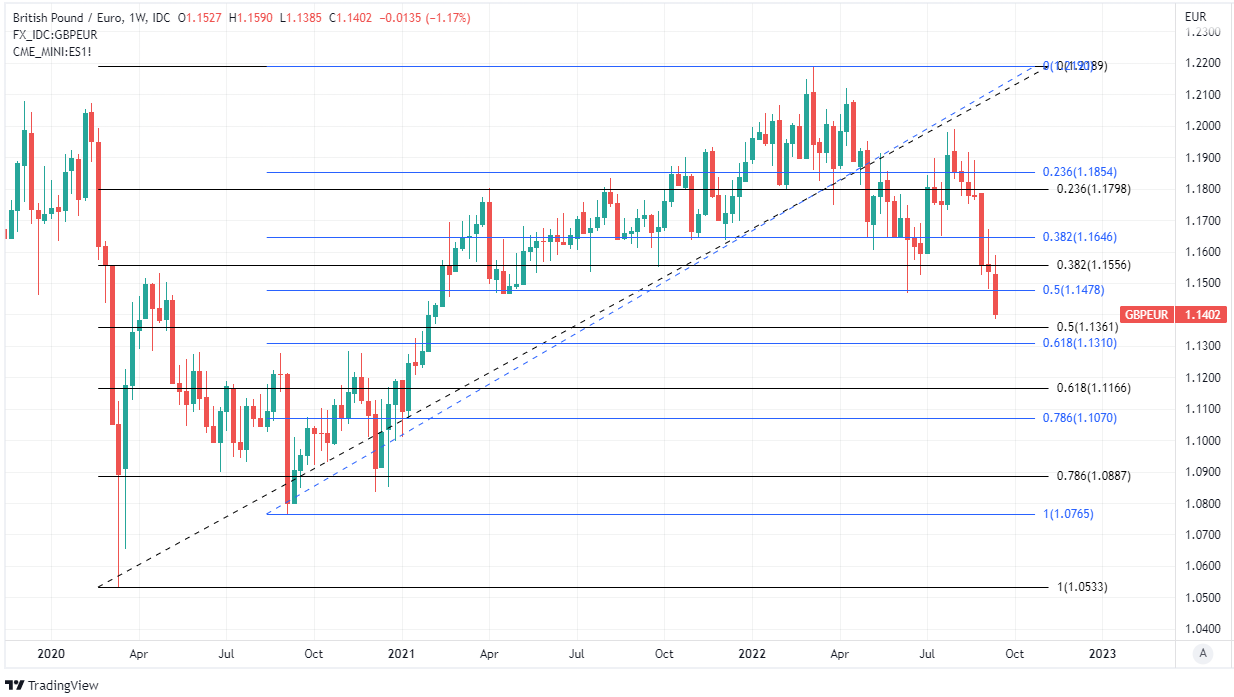 Above: Pound to Euro rate shown at weekly intervals with Fibonacci retracements of March and September 2020 recoveries indicating possible areas of technical support for Sterling.
Above: Pound to Euro rate shown at weekly intervals with Fibonacci retracements of March and September 2020 recoveries indicating possible areas of technical support for Sterling.
Compare Currency Exchange Rates
Find out how much you could save on your international transfer
Estimated saving compared to high street banks:
£25.00
Free • No obligation • Takes 2 minutes
This forecast is based on a number of assumptions including a Pound-Dollar rate that falls from of 1.14 to 1.0613, an inflation rate of 9.9%, a Bank Rate that rises to 3% and the idea that the Federal Reserve might be likely to move directly to whatever its estimate of the 'terminal rate' is on Wednesday.
The latter would effectively signal at least an intermittent end of the Fed's own interest rate cycle and may be enough to trigger a very large wave of profit-taking in U.S. Dollar exchange rates, which would have important indirect implications for GBP/EUR including the prospect of a midweek short-squeeze.
All of this could be very, very wildly wrong and readers should probably take that to be the case if it isn't realised within the week, although more important is how to view such an outcome if it proves to be correct.
After all, it would make fantastic fodder for political pundits.
However, and to the extent that any such losses reflect factors like those outlined above, any outsized declines this week might best be viewed as a case of a flexible and free-floating exchange rate doing what flexible and free-floating exchange rates sometimes do
Put differently; any such outcome should probably be viewed as a natural macroeconomic adjustment rather than as a cause for concern.
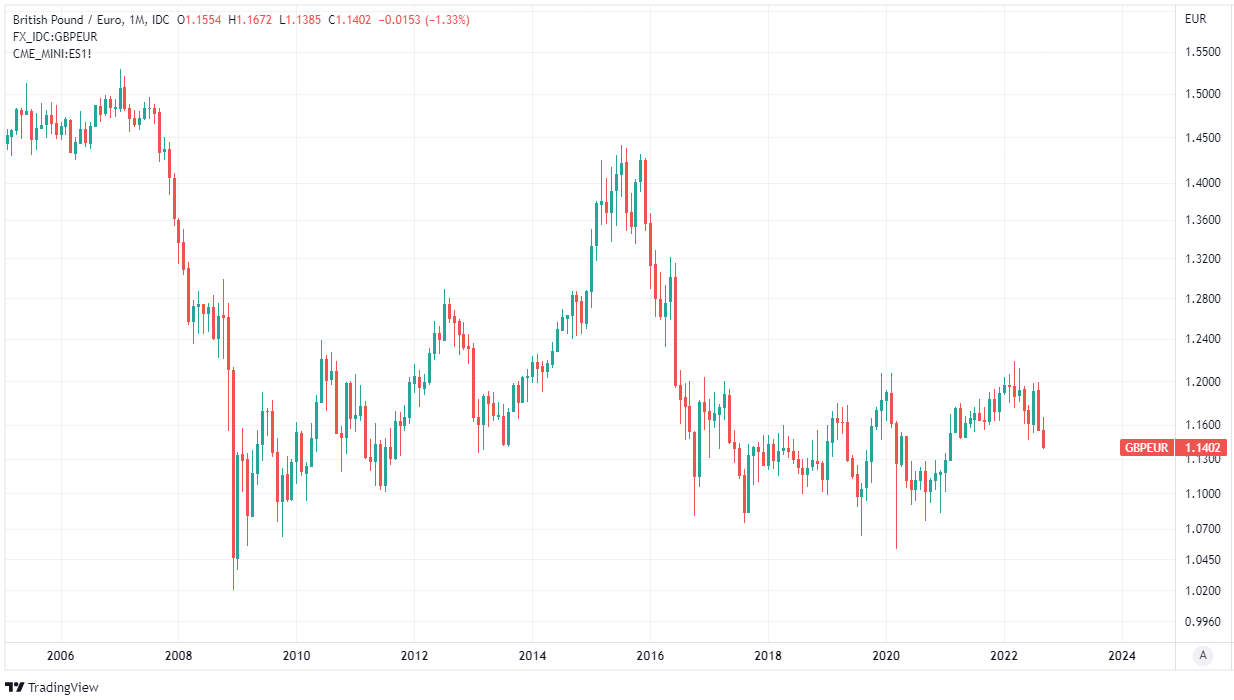 Above: Pound to Euro exchange rate shown at monthly intervals.
Above: Pound to Euro exchange rate shown at monthly intervals.

